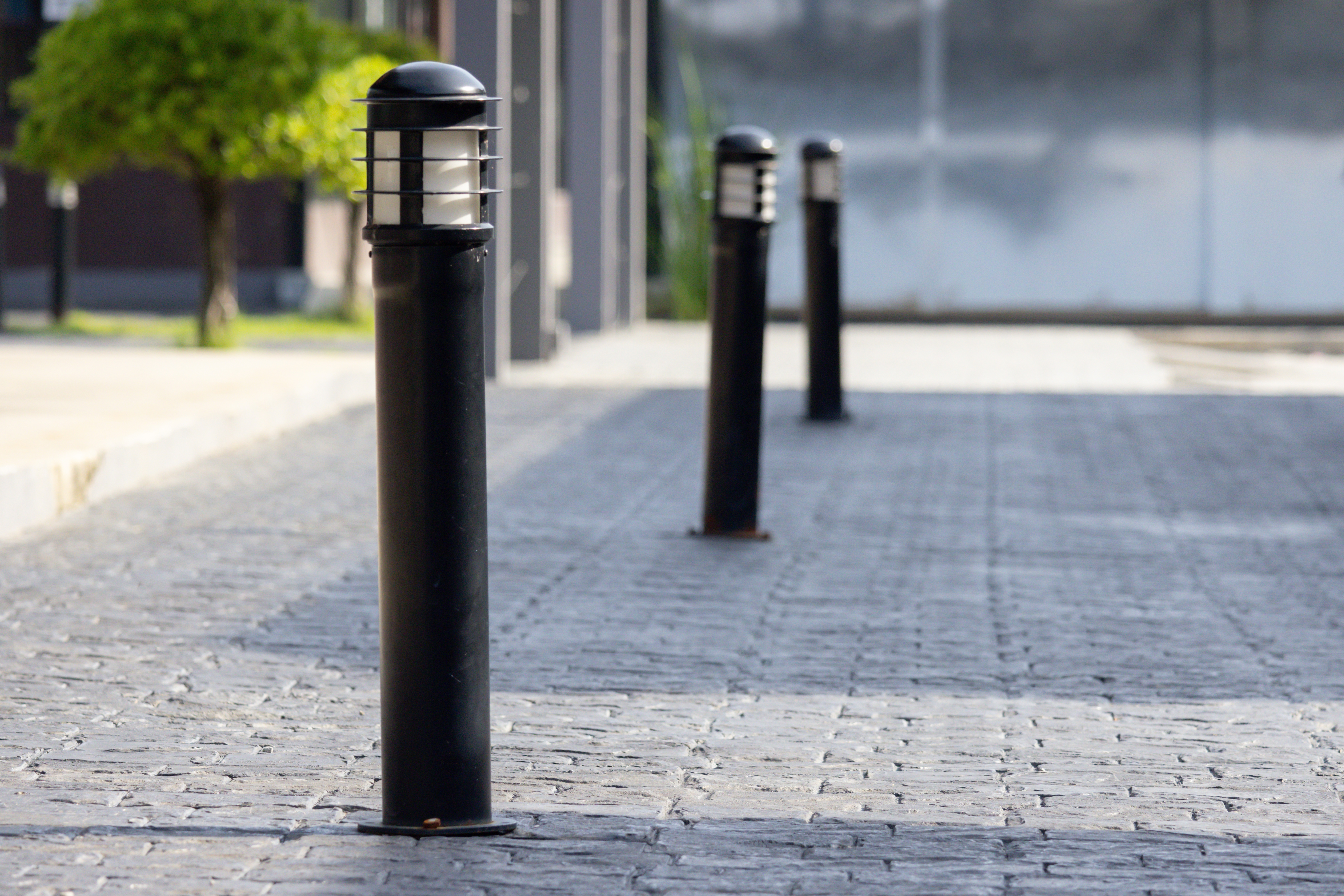Bollards are an essential part of our urban landscape, but many people might not even notice them. These simple but highly functional structures play a crucial role in safety, security, and traffic management.
If you’ve ever walked past a line of short posts arranged in a parking lot or along a sidewalk, you’ve encountered a bollard, even if you didn’t know what it was called. But their function goes far beyond their seemingly basic appearance.
A bollard is a short, sturdy post, often made from materials like metal, concrete, plastic, or wood, that serves as a physical barrier to control or direct traffic and to protect structures or pedestrians.
The word “bollard” itself comes from the nautical world, where similar posts were used to secure boats to docks. Over time, bollards have evolved from their maritime roots into versatile installations used in various settings for security, aesthetics, and even environmental control.
Related Topic: Integrating Security Bollards into Your Safety Plan
What Is the Purpose of a Bollard?
At first glance, bollards may seem like simple posts placed along roads or walkways, but their purpose is far more intricate. They serve as physical barriers to protect people, vehicles, and property. Whether placed at the entrance of a building, along a pedestrian walkway, or within parking lots, bollards are highly effective in ensuring safety and enforcing traffic management.

Bollards for Pedestrian Protection
One of the most common uses of bollards is for pedestrian safety. In busy urban areas, bollards serve as a protective barrier between traffic and pedestrians. By creating a physical divide, they prevent vehicles from encroaching on sidewalks, public spaces, or crowded areas. For example, outside government buildings or airports, these barriers provide an extra layer of protection against accidental or deliberate vehicle crashes.
Traffic Control and Regulation
Bollards are often strategically placed to regulate the flow of traffic in areas where vehicular access is restricted or needs to be slowed down. In city centers, they may prevent vehicles from entering pedestrian zones, reducing the risk of accidents. In parking lots or driveways, bollards can direct traffic into proper lanes and ensure that vehicles don’t stray into areas reserved for pedestrians or bicycles.
Related Topic: Choosing the Right Security Bollard Crash-Rating
Types of Bollards for Different Applications
The design and material of a bollard are chosen based on its intended function, which may be aesthetic, functional, or protective. Here are the primary types of bollards and their unique roles:
Fixed Bollards
Fixed bollards are stationary, permanent structures that serve as long-term barriers. They are often found protecting storefronts, banks, and public buildings from the risk of vehicle collisions. These bollards are typically made from reinforced concrete or steel, making them durable and difficult to move.
Removable Bollards
As the name suggests, removable bollards can be taken out and replaced with ease. They are ideal for spaces where traffic access needs to be flexible. For instance, in event spaces or loading zones, removable bollards can allow vehicles temporary entry and then be reinstated to block traffic when needed.
Retractable Bollards
Retractable bollards are highly versatile, capable of rising from the ground to create a barrier when needed and retracting back into the ground when not in use. These are commonly seen in areas with restricted access, such as private parking lots, commercial entrances, and pedestrian walkways. They provide an excellent balance between security and access control.
Automatic Bollards
Similar to retractable bollards, automatic bollards are controlled electronically. With the press of a button, these bollards can rise or lower, making them a convenient solution for high-security areas, such as military bases or government facilities. Their automatic function makes them particularly useful in places that need frequent changes in accessibility.
Crash-Resistant Bollards
Designed for high-impact protection, crash-resistant bollards can withstand the force of a vehicle collision, preventing cars from ramming through barriers. These bollards are essential in high-security areas where preventing unauthorized vehicle access is crucial, such as near embassies, airports, and pedestrian-heavy areas.
Related Topic: How Card Readers Enhance Your Security and Efficiency
Materials Used in Bollard Construction
The durability and effectiveness of a bollard largely depend on the materials used in its construction. Depending on the location and purpose, bollards can be made from various materials:
Concrete Bollards
Concrete is one of the most common materials used for bollards due to its strength and ability to absorb impact. Concrete bollards are often used in locations where a high level of protection is required, such as outside banks, government buildings, or storefronts. These bollards are strong enough to withstand crashes, offering protection for both pedestrians and buildings.
Steel Bollards
Steel bollards provide heavy-duty protection and are often reinforced with concrete to offer maximum durability. These are commonly used in industrial zones, high-traffic areas, or places requiring crash-resistant barriers. Steel bollards can be painted or coated for added protection against rust and weathering, ensuring they last longer in outdoor settings.
Plastic and Polyurethane Bollards
For low-impact areas where protection is still needed but flexibility is key, plastic and polyurethane bollards are often used. These bollards are designed to bend and flex without breaking, making them ideal for guiding traffic or marking off bike lanes. While not as strong as steel or concrete, they serve a critical role in traffic management.
Wooden Bollards
Wooden bollards are typically used in areas where aesthetics are as important as functionality. These bollards can blend into natural landscapes, parks, or historical sites while still providing a physical barrier for safety. They are often treated for outdoor use to prevent rotting or weather damage.
Related Topic: Fixed Bollards vs. Retractable Bollards: What’s Best for You?
Bollards and Their Role in Urban Design
Beyond their practical use, bollards also play a significant role in urban design. City planners and architects often integrate bollards into the overall aesthetic of an area, using them to enhance the visual appeal of public spaces while maintaining their essential function.
Aesthetic Bollards
Aesthetic bollards are designed with style in mind, blending into the architectural theme of their surroundings. They might feature decorative elements, such as unique shapes, engravings, or lighting fixtures. In cities, aesthetic bollards can enhance the look of sidewalks, promenades, or public squares while providing a functional barrier between pedestrians and vehicles.
Environmental Bollards
With sustainability becoming a core focus in urban planning, bollards are sometimes designed with eco-friendly features. For example, some bollards are equipped with solar panels to power integrated lighting, while others are made from recycled materials. These environmentally friendly options help reduce energy consumption and contribute to greener urban spaces.
Related Topic: Maximizing Safety: The Benefits of Crash-Proof Bollards
The Evolution of Bollards in Modern Infrastructure
Bollards have come a long way from their origins as simple posts used to moor boats. Today, they are a key part of modern infrastructure, balancing form and function in a wide range of settings.
From protecting pedestrians to controlling traffic and safeguarding buildings, the use of bollards is essential in designing safe, secure, and aesthetically pleasing urban spaces. They have become versatile tools in addressing the growing challenges of vehicle-related accidents and ensuring that public and private spaces remain accessible yet secure.
Final Thoughts:
Bollards may seem small, but their impact on safety, traffic management, and urban design is significant. These sturdy posts play a crucial role in protecting pedestrians, guiding vehicles, and enhancing the aesthetic appeal of public spaces.
Understanding the various types and uses of bollards helps us recognize their vital contribution to modern infrastructure. For top-tier solutions and expert advice on bollards, visit us a trusted leader in safety and access control systems.
FAQs
What is a bollard used for?
Bollards are used to control traffic, protect pedestrians, prevent vehicle access, and safeguard buildings from potential damage.
How do retractable bollards work?
Retractable bollards can be raised or lowered, either manually or automatically, to allow or restrict vehicle access to specific areas.
Can bollards stop a car?
Yes, certain bollards, especially crash-resistant ones, are designed to stop vehicles from entering restricted areas or causing damage.
What materials are used to make bollards?
Bollards can be made from concrete, steel, plastic, wood, and other materials depending on their intended function and setting.
Where are bollards commonly placed?
Bollards are commonly found in urban areas, pedestrian zones, outside buildings, parking lots, and areas where traffic control is necessary.
Are bollards customizable?
Yes, bollards can be customized in terms of design, material, and function to suit specific requirements, including aesthetics or security needs.


